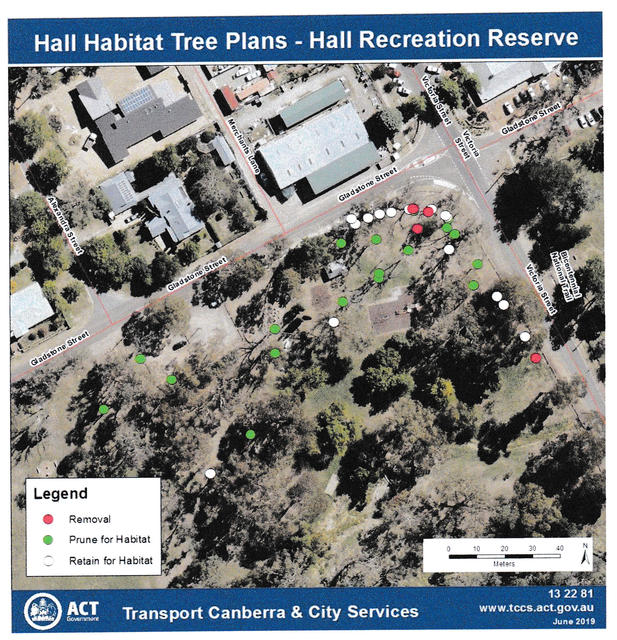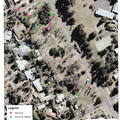Hall Tree Maintenance and Habitat Creation Plans
8 June 2019
The two reference plans are in the photo gallery.
The ACT Government Transport Canberra and City Services (TCCS) Directorate is responsible for the management and maintenance of Canberra's urban trees. TCCS have identified a number of ageing trees in the Hall Village precinct as requiring removal or maintenance in the form of habitat pruning to retain mature native trees.
Past consultation
- In February 2018 TCCS sent a letter to Hall residents advising of planned works for several veteran trees in the district. This included the removal, where necessary, of several trees, and the habitat pruning of veteran red gum trees that are in decline.
- On 20 June 2018, TCCS presented information on the project at a Village of Hall District Progress Association meeting.
- On 20 September 2018 the loss of mature native trees (including hollow-bearing trees) was formally identified as a key threatening process in the ACT under the Nature Conservation Act 2014.
- Since this time, TCCS has conducted an audit of the condition of trees in the district and consulted a woodland ecologist.
Tree Management Works
Tree Removal is considered against a set of criteria and is carried out only as a last resort when trees are structurally unsound and/or in irreversible decline.
Tree Planting is planned where suitable to replace the trees which will be removed. Tree species have been selected to provide the next generation of hollow-bearing trees suitable for the local ecosystem. Selected understory shrubs will be planted in addition to provide food sources for native fauna, in particular superb parrots.
Habitat pruning refers to removing small dead branches (less than 40mm in diameter) whilst retaining the larger branches and trunk as perches and habitat for native fauna. This minimises risk while allowing the retention of dead and dying hollow-bearing trees. Hollows can also be carved out of trees to maximise habitat benefits.
Habitat Benefits
Hollows in dead or dying trees provide key nesting and roosting sites for wildlife. Natural hollows form through damage and decay within trees, which allow small cracks to develop into larger cavities. This process can take 120-200 years and most commonly occurs in ageing Eucalypts.
Superb parrots are listed as a vulnerable species in the ACT and NSW. Due to widespread habitat loss and climate change, the future core range of the superb parrot will centre in and to the north of the ACT. To assist this vulnerable species, the retention of large hollow-bearing Eucalypts- in particular Blakely's red gums as are found in Hall- is critical.
Community members can report sightings of superb parrots through the Canberra Nature Map app canberra.naturemapr.org/
Planned Works
Remnant trees in Hall have been assessed, with TCCS staff identifying trees in need of removal, trees of habitat value that may be left as in, and trees which will benefit from pruning and hollow creation to remain safely in open space areas.
Work will commence in June 2019 and will be carried out as work programs and weather permit.
These plans are indicative and subject to change based on tree condition.




